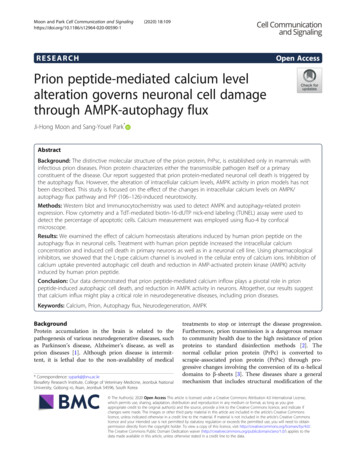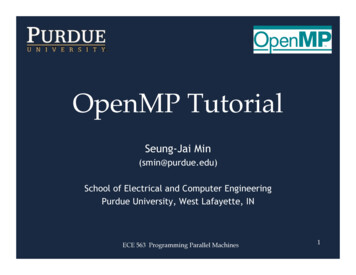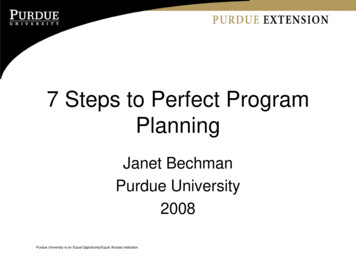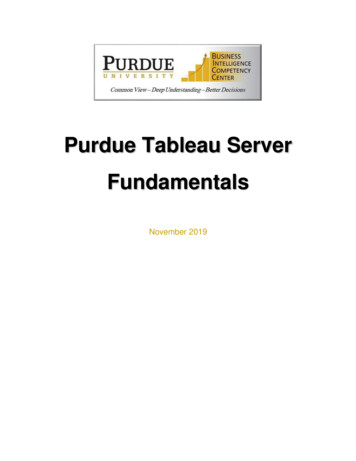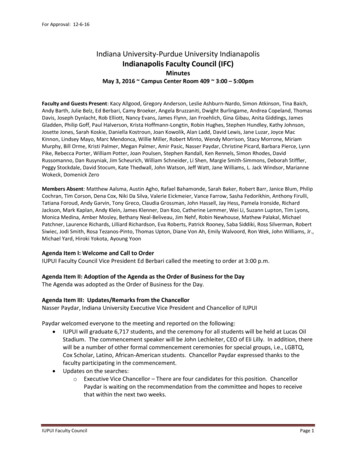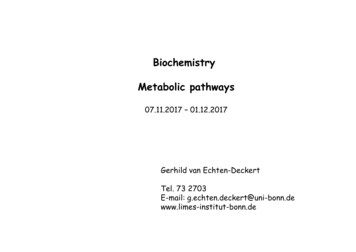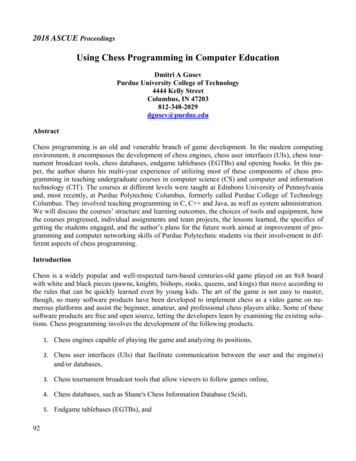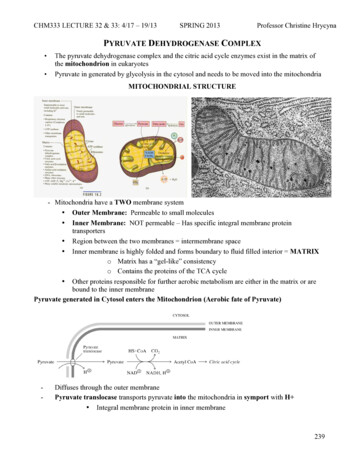
Transcription
CHM333 LECTURE 32 & 33: 4/17 – 19/13SPRING 2013Professor Christine HrycynaPYRUVATE DEHYDROGENASE COMPLEX The pyruvate dehydrogenase complex and the citric acid cycle enzymes exist in the matrix ofthe mitochondrion in eukaryotesPyruvate in generated by glycolysis in the cytosol and needs to be moved into the mitochondriaMITOCHONDRIAL STRUCTURE- Mitochondria have a TWO membrane system Outer Membrane: Permeable to small molecules Inner Membrane: NOT permeable – Has specific integral membrane proteintransporters Region between the two membranes intermembrane space Inner membrane is highly folded and forms boundary to fluid filled interior MATRIXo Matrix has a “gel-like” consistencyo Contains the proteins of the TCA cycle Other proteins responsible for further aerobic metabolism are either in the matrix or arebound to the inner membranePyruvate generated in Cytosol enters the Mitochondrion (Aerobic fate of Pyruvate)-Diffuses through the outer membranePyruvate translocase transports pyruvate into the mitochondria in symport with H Integral membrane protein in inner membrane239
CHM333 LECTURE 32 & 33: 4/17 – 19/13SPRING 2013Professor Christine HrycynaCONVERSION OF PYRUVATE TO ACETYL COAThe pyruvate dehydrogenase complex LINKSGLYCOLYSIS TO THE TCA CYCLE! - also occurs inmitochondria Pyruvate DehydrogenaseComplexPyruvate dehydrogenasecomplex (PDH complex) isa multienzyme complexcontaining:3 enzymes 5 coenzymes other proteins( ATP coenzyme as a regulator)E1 pyruvate dehydrogenaseE2 dihydrolipoamide acetyltransferaseE3 dihydrolipoamide dehydrogenaseStructure of thepyruvate dehydrogenase(PDH) complexOverall reaction of pyruvate dehydrogenase complex Multienzyme Complex (36 subunits!) pyruvate CoASH NAD acetyl-CoA CO2 NADH H 240
CHM333 LECTURE 32 & 33: 4/17 – 19/13SPRING 2013Professor Christine HrycynaRoles of the coenzymes of the PDH complex- TPP (thymine pyrophosphate) Active form of thiamineo Vitamin B1o Beans, green vegetables, sweet corn, egg yolk, liver, corn meal, brown riceo Deficiency beriberi TPP often used for decarboxylation reactions-Lipoic Acid -FAD and NAD -Acetyl transfer and oxidation reactionsOxidizing agent/electron acceptors à Getreduced (will be later reoxidized)Coenzyme A (CoA-SH) Synthesized from the vitamin pantothenic acid Has a free thiol (-SH) group241
CHM333 LECTURE 32 & 33: 4/17 – 19/13SPRING 2013Professor Christine HrycynaCoenzyme A has a free thiol group (CoASH) that can form thioesters which are energyrich compounds (high free energies of hydrolysis - ΔG ’ -31 kJ/molo Energizes moleculeso Makes more unstable and more prone to react and release energy Thioester linkage(joins thiol with carboxylic acid)SUMMARY:-Net reaction is SIMPLE – Process in COMPLEX!Pyruvate is now activated ready to enter the TCA cycle as Acetyl-CoA!5 Reactions of the Pyruvate Dehydrogenase Complex242
CHM333 LECTURE 32 & 33: 4/17 – 19/13SPRING 2013Professor Christine HrycynaTCA CYCLE (Citric Acid Cycle) The Citric Acid Cycle is also knownas:– Kreb’s cycle Sir Hans Krebs Nobel prize, 1953– TCA (tricarboxylic acid) cycle The citric acid cycle requires aerobicconditions!!!!TCA CYCLE–Cells have evolved to useoxygen–Oxygen serves as the finalelectron acceptor as pyruvate(from glycolysis) is converted(oxidized) completely to CO2and H2O If cell is under anaerobicconditions energy productionis not too efficient - 10% ofenergy possible is generated Pyruvate converted toAcetyl-CoA by PDH andthen Acetyl-CoA enters theTCA cycleEnergy in the citric acid cycle Energy of the oxidationreactions is largely conservedas reducing powerCoenzymes reduced:- NAD /NADH- FAD/FADH2 Reduced coenzymes used byelectron transport chain andoxidative phosphorylation tomake ATP243
CHM333 LECTURE 32 & 33: 4/17 – 19/13SPRING 2013Professor Christine HrycynaThe Tricarboxylic acid (TCA) cycle (citric acid cycle) is amphibolic (both catabolic and anabolic)The TCA Cycle Serves Two Purposes:1. Oxidize Acetyl-CoA to CO2 to produce energy- ATP (GTP)- Reducing power of NADH and FADH2- The cycle is involved in the aerobic catabolism ofcarbohydrates, lipids and amino acids2.Supply precursors for biosynthesis ofcarbohydrates, lipids, amino acids, nucleotides andporphyrins Intermediates of the cycle are starting pointsfor many biosynthetic reactions The cycle itself is not a pathway for a netdegradation of any cycle intermediatesCycle intermediates can be shared with otherpathways, which may lead to a re-supply ornet decrease in cycle intermediatesReactions feeding into the cycle replenish thepool of cycle intermediates Fundamental Differences between Glycolysis and TCA Cycle:1.2.3.Glycolysis is a linear pathway; TCA cycle is cyclicGlycolysis occurs in the cytosol and TCA is in the mitochondrialmatrixGlycolysis does not require oxygen; TCA requires oxygen(aerobic)Summary of the citric acid cycleFor each acetyl-CoA that enters the cycle:(1) Two molecules of CO2 are released(2) Coenzymes NAD and FAD arereduced(3) One GDP (or ADP) is phosphorylated(4) The initial acceptor molecule oxaloacetate is reformedFADH2H2Energy conservation by the cycle Energy is conserved in the reduced coenzymes NADH, FADH2 and one GTP244
CHM333 LECTURE 32 & 33: 4/17 – 19/13SPRING 2013Professor Christine Hrycyna NADH, FADH2 can be oxidized to produce ATP by oxidative phosphorylation Energy is also conserved in either ATP or GTP- produced by substrate-level phosphorylation(from the thioester bond in succinyl-CoA.) The use of many steps in the oxidation of acetyl CoA to CO2 enables conservation of most of theenergy as work with little lost as heat245
CHM333 LECTURE 32 & 33: 4/17 – 19/13SPRING 2013Professor Christine Hrycyna8REACTIONS OF THE TCA CYCLE:1. Formation of Citrate Citrate formed from condensation of acetyl CoA and oxaloacetateAddition of acetyl to the keto double bond of OAA aldol condensationOnly cycle reaction with C-C bond formationNo energy of ATP hydrolysis neededSynthase is an enzyme that catalyzes addition to a double bond or elimination to form a doublebond without needing ATP hydrolysisBoth Hydrolysis Reaction and Non-hydrolytic cleavage (addition or elimination)246
CHM333 LECTURE 32 & 33: 4/17 – 19/13 SPRING 2013Professor Christine HrycynaLocoweed is toxic because it accumulates fluoroacetate2. Aconitase Isomerization of citrate (3 alcohol) to isocitrate (2 alcohol)Aconitase contains an iron-sulfur center as a prosthetic groupCatalyzes a lyase reaction that results in rearrangement of citrate with a tertiary alcohol toisocitrate with a secondary alcoholNon-hydrolytic cleavage (addition or elimination)Goes through an enzyme bound cis-aconitate intermediateElimination of H2O from citrate to form C C bond of cis-aconitateRearrangement allows the further oxidation of the molecule247
CHM333 LECTURE 32 & 33: 4/17 – 19/13SPRING 2013Professor Christine Hrycyna3. Isocitrate Dehydrogenase First oxidative decarboxylation of isocitrate to α-ketoglutarate (α-kg) Metabolically irreversible reaction One of four oxidation-reduction reactions of the cycle Also a Non-hydrolytic cleavage reaction (addition or elimination) Hydride ion from the C-2 of isocitrate is transferred to NAD to form NADH Oxalosuccinate is decarboxylated to α-ketoglutarate4. α-Ketoglutarate Dehydrogenase Complex-Second oxidative decarboxylation reaction-Also a Non-hydrolytic cleavage reaction (addition or elimination)-α-Ketoglutarate converted to Succinyl-CoA-Similar to pyruvate dehydrogenase complex except a succinyl group is activated, not acetyl Same coenzymes, identical mechanisms-Succinyl-CoA thioester is VERY high energy-Generates NADH248
CHM333 LECTURE 32 & 33: 4/17 – 19/13-SPRING 2013Professor Christine HrycynaPurpose of step: Collect energy from α-ketoglutarate decarboxylation into the high energysuccinyl-CoA molecule5. Succinyl-CoA Synthetase (Formation of succinate) Free energy in thioester bond of succinyl CoA is conserved as GTP (or ATP in plants, somebacteria)Enzyme: Succinyl-CoA Synthetase Two forms in higher animals: One prefers ADP the other GDP) SUBSTRATE-LEVEL PHOSPHORYLATION Formation of ATP directly coupledto the reaction (group transfer reaction) Only step where ATP (GTP) is formed directly in the TCA cycle All other ATP is produced by oxidative phosphorylation Oxidative phosphorylation is the oxidation of reduced co-factors NADH andFADH2 to O2 – release of energy drives ATP formation from ADP PiGTP249
CHM333 LECTURE 32 & 33: 4/17 – 19/13SPRING 2013Professor Christine Hrycyna6. The Succinate Dehydrogenase (SDH) Complex Located on the inner mitochondrial membrane (other components are in the matrix)Oxidation-reduction reaction that forms a carbon-carbon double bondSuccinate is oxidized to fumarate, while FAD is reduced to FADH2 NAD functions in reactions that interconvert hydroxyl and carbonyl groupsDehydrogenation is stereospecific; only the trans isomer is formedAlso known as Complex II of the electron transport chain – direct feed of electrons fromFADH2 into the electron transport chain.Substrate analog malonate is a competitive inhibitor of the SDH complexMalonate is a structural analog of succinateMalonate binds to the enzyme active site, and is a competitive inhibitor250
CHM333 LECTURE 32 & 33: 4/17 – 19/13SPRING 2013Professor Christine Hrycyna7. Fumarase Stereospecific trans addition of water to the double bond of fumarate to form L-malate-Only forms the L-isomerNon-hydrolytic cleavage reaction8. Malate Dehydrogenase-Regeneration of oxaloacetate from Lmalate-Enzyme: malate dehydrogenase(oxidation – reduction reaction)-Generates NADHOVERALL SUMMARY OF TCACYCLE:1. Oxidation of Acetyl-CoA to CO2- CO2 leaves at steps 3 and 42. 3 NAD are reduced to NADH bydehydrogenase reactions-Steps 3, 4, and 8-isocitrate dehydrogenase-α ketoglutarate dehydrogenase-malate dehydrogenase3. 1 molecule of FAD reduced to FADH2-Step 6 – Succinate dehydrogenase4. 1 phosphoanhydride bond formed in ATPor GTP-Substrate level phosphorylation at step 5: Succinyl-CoA Synthetase-Generated from energy stored in CoA thioesterSo, per pyruvate:4 NADH (one from pyruvate dehydrogenase complex 3 TCA)1 ATP or GTP1 FADH2251
CHM333 LECTURE 32 & 33: 4/17 – 19/13SPRING m/ Professor Christine HrycynaChapter 16Fig. 16-2 -- The Reactions of the Citric Acid CycleENERGY FROM THE TCA CYCLE:Reduced Coenzymes Fuel the Production of ATP Each acetyl CoA entering the cycle nets:(1) 3 NADH(2) 1 FADH2(3) 1 GTP (or 1 ATP) Oxidation of each NADH yields 2.5 ATP Oxidation of each FADH2 yields 1.5 ATP Complete oxidation of 1 acetyl CoA 10 ATPGlucose degradation via glycolysis, citric acidcycle, and oxidative phosphorylationAEROBIC TOTAL/glucose 32 ATP252
CHM333 LECTURE 32 & 33: 4/17 – 19/13SPRING 2013Professor Christine HrycynaIf anerobic – Lactate is formed from pyruvate after glycolysis by lactate dehydrogenase and the NADHformed is USED. Therefore, net gain of 2 ATP/glucose, not 32! (Hence 5-10% efficiency)- Occurs in muscles duringexercise because they go intooxygen debt.- Soreness due to H fromlactic acid- Metabolism in musclesreturns to normal whenoxygen replenished**Should be able to determine#ATP produced given a startingand stopping point in glycolysisor citric acid cycle. (i.e. knowwhere NADH/FADH2 or ATP aremade and how many.Regulation of the Citric Acid Cycle Regulation depends on the ENERGY LEVEL of cells– key to keep energy level constant When cells have lots of energy (ATP, NADH), thereactions involved in making more are slowed The reverse is also true.Pathway controlled by:(1) Small molecule modulators (products of thecycle can inhibit)(2) Covalent modification of cycle enzymes(3) Supply of acetyl CoACitrate Synthase isalso regulated:( ) ADP(-) NADH,succinyl-CoA,citrate, ATPRegulation of the PDH complex-Highly regulated-Regulation of pyruvate dehydrogenase complexcontrols acetyl CoA supply-Gatekeeper to aerobic metabolism-Represents the committed step because pyruvate can still go back to glucose (gluconeogenesis)but acetyl-CoA cannot go back to glucose.-Inhibitors: Indicators of high energy statusPOINTS OF REGULATIONo NADH, ATP, Acetyl-CoA, Fatty acids (degraded to form acetyl-CoA)-Stimulators: Indicators of low energy statuso AMP, NAD , Coenzyme A (CoA-SH)253
CHM333 LECTURE 32 & 33: 4/17 – 19/13SPRING 2013Professor Christine HrycynaRegulation of citrate synthase- Inhibitors: NADH, ATP, succinyl-CoA, citrate- Stimulators: ADPRegulation of isocitrate dehydrogenase (ICDH)- Inhibitors: NADH and ATP- Stimulators: NAD , ADP and Ca 2Regulation of α-ketoglutarate dehydrogenase complex- Inhibitors: NADH, ATP and succinyl-CoA- Stimulators: NAD , ADP, / Chapter 16Fig. 16-14 -- Regulation of the Citric Acid CycleAnaplerotic Reactions Replenish TCACycle Intermediates:1. Pyruvate Carboxylase convertspyruvate to oxaloacetate.Activated by Acetyl-CoA! Increases theflux through TCA cycle.2. Degradation of odd numbered fattyacids yields succinyl-CoA3. Degradation of amino acids producesother intermediates.254
complex (PDH complex) is a multienzyme complex containing: 3 enzymes 5 coenzymes other proteins ( ATP coenzyme as a regulator) E1 pyruvate dehydrogenase E2 dihydrolipoamide acetyltransferase E3 dihydrolipoamide dehydrogenase Structure of the pyruvate dehydrogenase (PDH) c
